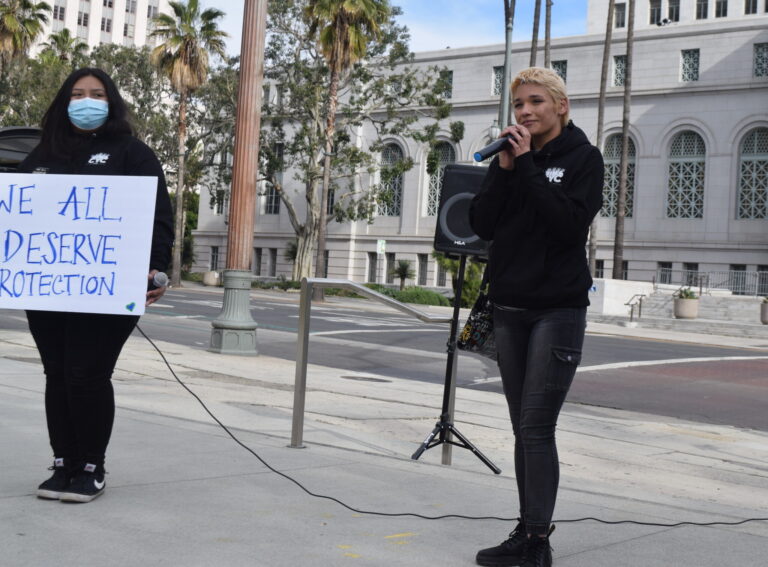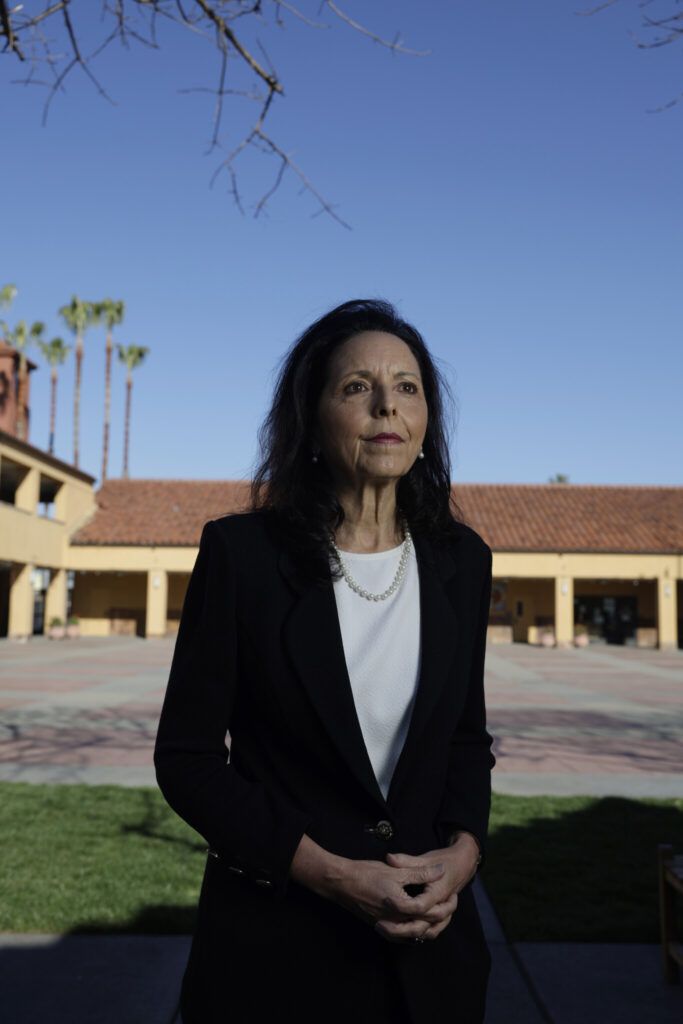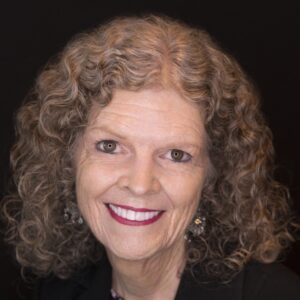JUVENILE JUSTICE |
By Julie Reynolds Martinez and Jeremy Loudenback
Katherine Lucero — a daughter of farmworkers and longtime juvenile court judge who calls for compassion and support rather than jail and foster care — is now leading the most populous state toward a once-unimaginable goal: a future without youth prisons.
In a historic shift aimed at reversing decades of poor outcomes for youth offenders and public safety, California is closing its Division of Juvenile Justice. Now it’s the job of former Santa Clara County Superior Court Judge Lucero, that court’s first appointed Latina judge, to smooth the transition from punishment to a more therapeutic approach.
Her new title is director of the newly minted Office of Youth and Community Restoration, an agency that is not located within the sprawling corrections system, but rather, the state’s health and human services agency.
“She is flat out one of the bright lights in California’s judiciary,” said retired Santa Clara County Judge Leonard Edwards, who hired Lucero to be a dependency court commissioner more than 20 years ago. The former prosecutor went on to succeed Edwards as supervising judge in 2006. “She’s a terrific leader who knows how to get off the bench and into the community, how to bring people together to work on issues.”
When the state sought her leadership to oversee the re-envisioned California youth justice system, Lucero, 60, said the opportunity made sense. She calls the “over-incarceration of Black, brown and Native youth” something that justice system leaders can’t be afraid to tackle in a more substantive way. She urges “creative” approaches in handling the cases of youthful offenders, who come from “the least-resourced neighborhoods, where schools no longer have mental health counselors, sports, art, drama or librarians.”
In a recent interview with Voices, Lucero said she was “very taken with the idea of closing the statewide youth prison system and then realigning the care of our youth back to their communities, where they have homes and families, lifelong friendships. Who wouldn’t want to be part of this major undertaking?”
She described shifting state control to counties as part of a larger culture change: “Treating youth as people, not as criminals who should be punished for all time.”
‘A comprehensive systems change’
Law enforcement’s response to the change has been measured, as probation departments face growing responsibility to house and supervise those young people the state has deemed most dangerous.
The Chief Probation Officers of California, along with the California State Association of Counties and several other agencies strongly opposed shutting down the state juvenile division, calling an early proposal “unworkable.” An August 2020 joint memo stated that the creation of an “untested state bureaucracy” would divert “critical funding away from direct services to youth.”
These days, county probation leaders say the new office has an important role to play. Chief Probation Officers of California Executive Director Karen Pank said in an emailed statement that her members “welcome the state maximizing its resources and providing help such as technical assistance where there are current gaps.” Pank also said counties will look to the state office for “their expertise to enhance our ability to meet the needs of youth and make this policy change safe and successful.”
But the pleas for fundamental change continue, as was evident at a recent rally in downtown Los Angeles. Dozens of youth advocates chanted and waved signs in support of legislation that would provide a bill of rights to teens held in juvenile detention facilities.
In addition to providing technical assistance to counties, Lucero’s new agency will be responsible for investigating complaints, resolving them and producing and publishing regular reports to the Legislature. To that end, the office will soon hire the state’s first-ever youth justice ombudsperson. For young people like Mialissa Flores, who have spent time behind bars, outside scrutiny of conditions inside detention facilities is long overdue.

Mialissa Flores spoke during a recent Los Angeles demonstration, where dozens of young people rallied in support of a bill of rights for incarcerated youth. | Photo, Jeremy Loudenback.
Flores, who was first detained at San Diego County’s juvenile hall at age 13, said she wants the new official leading the Office of Youth and Community Restoration to address the grievances of incarcerated young people, and to uphold basic standards of care inside lockups. Now 21, Flores said during several stints in juvenile hall, she wasn’t even given warm enough clothes or basic hygiene products. And probation officers minding her didn’t seem to care about her well-being.
“We need somebody who knows that these are children, that they’re growing, developing and going through puberty in a juvenile hall,” Flores said. “They’ve made mistakes but they shouldn’t be treated like animals.”
The state’s new Office of Youth and Community Restoration was created in 2020 by Senate Bill 823, which maps out the shuttering of the long-troubled youth prison system, once known as the California Youth Authority and more recently as the Division of Juvenile Justice. The new statewide office will no longer be a part of the California Department of Corrections and Rehabilitation. As part of a fundamental shift in how the state now views its young charges, it is now placed under the California Health and Human Services Agency. Lucero calls that “a huge signal to our communities that we see youth as a different kind of law violator than we do adults.”
Sue Burrell, policy and training director with the nonprofit Pacific Juvenile Defender Center, said Lucero and her office will be crucial to realizing the transformation envisioned under SB 823 — a premise that most youth who commit crimes are in need of treatment for trauma, that their lives have value, and they can return safely to society if given some investment of education and therapeutic intervention. The Office of Youth and Community Restoration will collect data, monitor grievances through a new ombudsperson, administer grants and advise counties on appropriate programming and services that better support youth and reduce recidivism.
“This is the moment that can make or break a long history of thinking that we can put youth in institutions to make them better,” Burrell said. She also noted the instrumental role Lucero will now play: “I’m hoping that she will embrace the intent and the spirit of the new law and make sure that she doesn’t just replace one big state institutional system with 58 small ones.”
Burrell is among those longtime youth justice advocates who have spent decades fighting once-Dickensian conditions inside state facilities — youth confined to isolation cells for 23 hours a day, violent treatment by staff, and school and recreation provided to youth in structures that were literally cages.
Now, despite the hope of these justice reformers, there are concerns that there may soon be not just a handful of facilities to monitor for fair treatment, but scores of them.
Will Lucero’s office be up to the task?
The office got off to a contentious start last year, when Gov. Gavin Newsom’s administration set aside an annual $3 million and 19 positions in his initial budget ask. That alarmed advocates who said that was far too little for the office to do an adequate job overseeing 58 county-run juvenile justice systems. Although Newsom eventually provided a one-time influx of about $28 million in start-up funding to the agency’s coffers and increased the number of staffers to 33, there are still concerns about whether it has sufficient enforcement authority.
In an interview, Assemblymember Mark Stone (D) said he remains concerned that youth in some parts of the state will miss out on the reforms if Lucero’s office can’t hold counties to a common set of standards, standardizing rehabilitative offerings for all state residents. Like other justice-watchers, he worries that the quality of youth justice in California could soon amount to simple geography — those in the progressive Bay Area will receive counseling and have opportunities to garden and learn a trade, while in the more tough-on-crime Central Valley counties, the same kid who committed the same crime might simply be locked away in a juvenile hall cell, with scant opportunity to remake themselves.
“We’ve thrown a bunch of money at them and then are kind of washing our hands of accountability and results,” Stone said of the state’s counties. “And to me, that’s very dangerous when we’re dealing with kids and their futures.”
Healing families, not just kids
Lucero began her career as a deputy district attorney. Beginning as judicial officer in 2000, she went on to lead the San Jose-based child dependency division, and later supervising and presiding judge of its juvenile justice court.
Lucero left her mark in the South Bay with her support for the creation of specialty courts that approach families with a less punitive and more therapeutic approach. Her courtrooms were named Girls Court, Zero to Three Dependency Drug Treatment Court, and Family Wellness Court — aiming for more lasting solutions to people’s problems. Instead of lawyers facing off in court, clients were offered mental health care, housing opportunities and a team approach to stabilizing their lives.
Throughout, she brought lessons from her background to bear.
Lucero is a rare judicial officer who openly shares her personal history. In a video posted on the Santa Clara County courts website, she sits at her desk, her shiny black hair gathered in a bun much like the Frida Kahlo portrait on the wall behind her.
To handle the pressures of her work, Lucero and her husband of 30 years practice yoga on most mornings. She said she also relies on “strong mentors,” who she stays connected with throughout the week and who remind her “that I do not have to tackle difficult problems on my own.”
Lucero has two adult daughters — one is a comedic actress and a yoga instructor, and another is an attorney. “They are both amazing in every way,” she said.

As a dependency court judge, Katherine Lucero saw families whose experiences mirrored her own childhood. | Photo, Josie Lepe
Lucero’s childhood had struggles. She describes growing up with a father who was an “active alcoholic” until she was 15, and identifying with the families she sees before her in the dependency and delinquency courtrooms. Because of her experience, however, she also knows about transformation.
“I grew up in a household that looked very similar to the households that I saw in juvenile dependency court,” Lucero says in the video.
But her father stopped drinking when she was a teenager. “I saw him get better, and I saw my family heal,” she said. “I got to see my dad become a man of great respect in our community.”
From the bench, Lucero fought for more time on cases, pushing the courts to better evaluate critical turning points for children who were often rushed through dockets like goods on a conveyor belt. Early in her juvenile court career, she tackled the sheer volume of cases, and the impact on vulnerable families’ lives. Among the most life-changing courtroom scenes were the “detention” hearings in dependency court, where judges decide whether a child can live with parents or must enter foster care. With overloaded calendars and high caseloads, often a family’s fate was determined in mere minutes.
Lucero changed court schedules so parents and lawyers could meet in the mornings before hearings, “giving families the time they needed and deserved,” she said. Family “engagement rooms” were set up to keep youth and parents connected “even through the struggle” of foster care separation. Afternoon hearings were allotted a full 30 minutes, which, in 2006, was considered a lot of time to discuss matters as serious as whether a teenager would go to a group home, or whether a parent’s custody rights should be permanently terminated.
When decisions like that were being made, she said: “We just wanted to be very thoughtful.”
Santa Cruz County expects to farm out some higher-security youth to Sonoma County, more than 100 miles to the north.
Juvenile justice goes local
California’s juvenile justice system is in the middle of a seismic shift that Lucero will now lead. In the years leading up to the Division of Juvenile Justice shutting down, the number of youth ages 12 to 25 locked up by the state has dropped almost unimaginably — from an average daily population of roughly 10,000 in 1996 to fewer than 700 last year. As of July 1, the state no longer accepts most new commitments, and its four remaining prisons will be closed by June 30, 2023.
Local juvenile halls, which house minors awaiting trial or serving time for less serious offenses, have also seen huge drops in population. In 2002, California counties housed an average of 11,124 youth a day in their juvenile detention facilities. In 2021, that number fell to 2,162, according to state figures.
All 58 counties met the Jan. 1 deadline for turning in their “realignment” plans to house even those youth who have committed the most serious and violent offenses in local facilities, Lucero said. And they’re slated to receive $100 million by the state to spend on local capacity.
But a reading of the details shows a patchwork of approaches, not all of which are fully in sync with Lucero’s vision.
Progressive Santa Cruz County had only four youth in DJJ facilities as of November, probation chief Fernando Giraldo said. But in its plan presented to Lucero’s office, the county said it expects to farm out some higher-security youth to Sonoma County, another liberal county more than 100 miles to the north.
Santa Cruz has an “older and smaller” juvenile hall, the plan says, and housing young people whose ages range from 13 to 25 could present problems “if they cannot be adequately separated and housed in different units.”
Santa Cruz expects to receive at total of $984,429 by 2024, when the DJJ’s realignment will be in “full implementation,” and it will invest heavily in therapeutic approaches with an emphasis on correcting racial imbalances in its juvenile justice population.
The county also got a grant for $47,086 to buy a passenger van so families can visit children in Sonoma County, as well as “digital devices and WiFi units to ensure youth and their families are connected.”
Monterey County is in the middle of extremes. It has 30 youth in the DJJ, and is slated to receive nearly $8.7 million over three years, according to its plan, which is largely based on expanding existing therapeutic programs. The county can house eight to 10 wards in a Secure Youth Treatment Facility inside its new juvenile hall, which has the capacity for “the older and/or more challenging youth to be housed in an area away from younger, less sophisticated youth.”
However, the plan said Monterey is considering contracting some services to other counties, including treatment for young sex offenders, girls and for mental health treatment.
But in more conservative Kern County — which had 45 youth in state custody as of January 2021 — the plan is a tougher approach. Kern county will use $12.5 million to house its most serious offenders in a pod in the 120-bed Kern Crossroads facility, where correctional officers are trained in “de-escalation techniques as well as Crisis Prevention Intervention and defensive tactics.” Kern County’s plan states that “youth will be held accountable for misbehavior but also provided with an opportunity to redirect their negative behavior.”
Back on their paths
Despite heel-dragging in some regions of the state, the changes underway in California juvenile justice are a significant departure from the past. Besides shutting down its youth prisons, the state now prohibits children aged 15 and under from being tried as adults, no matter the crime.
“Looking at the brain science, we’re seeing that youth are incredibly resilient,” Lucero said. “And so we’re offering education more than just a surveillance model. We don’t just have to focus on one moment in time when you made a bad choice. We have to ask not just ‘what did you do,’ but ‘what happened?’”
In the 81 years since founding the Youth Authority in 1941, the state has locked up tens of thousands of juveniles considered too dangerous to remain in their homes and communities. Now, California is reversing course, teaching young people how to make amends for their actions through restorative justice, education and therapy so they can, as Lucero puts it, “get back on their paths.”
It’s a model she says the nation would do well to follow.
“I think we’re on to something,” she said.
An earlier version of this story appeared in The Imprint.
Have something to say about this story? Send us a letter.
GET OUR FREE WEEKLY NEWSLETTER![]()
FEATURED IMAGE: Katherine Lucero is the director of the Office of Youth and Community Restoration, a new agency that will oversee the replacement of California’s youth prison system with community-based services and supports. | Photo, Josie Lepe
